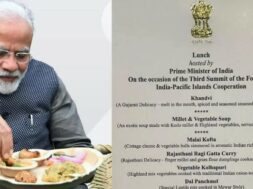
Lunch diplomacy: PM Modi’s lunch for FIPIC guests showcased Indian varieties, cuisines
Virendra Pandit
New Delhi: Prime Minister Narendra Modi’s lunch for leaders of the Forum for India-Pacific Islands Cooperation (FIPIC) in Papua New Guinea showcased the diversity of Indian cuisines.
The Indian PM along with his Papua New Guinea counterpart James Marape co-hosted a key Summit between India and 14 Pacific Island countries to boost bilateral ties. PM Modi is the first Indian PM to visit the Pacific nation.
Indian cuisine and millets found a prominent place at the banquet lunch PM Modi hosted for the leaders attending the third FIPIC Summit.
The lunch included Khandvi, a popular delicacy from PM Modi’s home state of Gujarat; millet and vegetable soup made with Kodo millet and highland vegetables served with cornbread; malai kofta (cottage cheese and vegetable balls simmered in aromatic Indian rich kofta curry); Rajasthani ragi gatta curry, prepared with finger millet and gram flour dumplings cooked in sour gravy; vegetable Kolhapuri (a mix vegetable cooked with traditional Indian onion-tomato gravy) and dal panchmel (special lentils mix cooked in Mewar style).
Millet biryani, vegetable biryani made with nutrient-rich barnyard millet, and nannu fulka, bread made with wheat flour were also served.
Besides, the menu included desserts and beverages like masala chhaas, drinks made with creamy yogurt and Indian spices; paan kulfi, betel leaves flavored milk-based Indian dessert, and malpua with rabdi, an Indian sweet pancake.
The inclusion of millets in the menu reflects the importance India gives to millets and the efforts New Delhi is making to raise awareness about food security and nutrition. Recently, PM Modi renamed millets as “Shree Anna.”
At India’s initiative in March, the United Nations General Assembly (UNGA) declared the year 2023 as the International Year of Millets to raise awareness of these grains for food security and nutrition, enhance investment in R&D and extension, and inspire stakeholders towards improving production, productivity and quality of millets.














